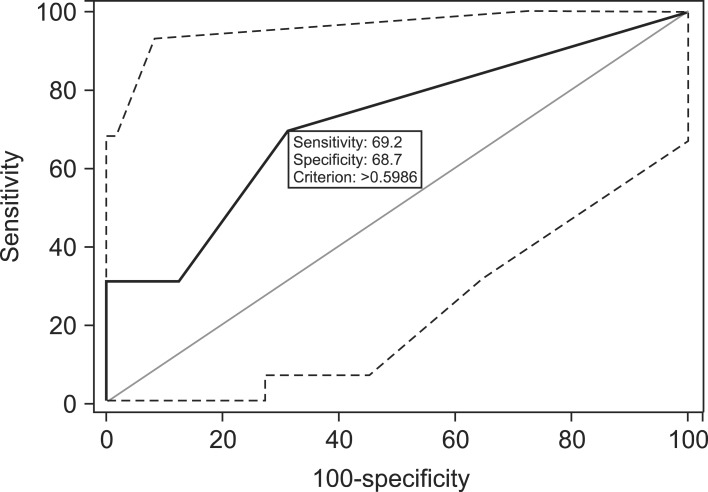Korean J Hepatobiliary Pancreat Surg.
2013 Nov;17(4):166-170. 10.14701/kjhbps.2013.17.4.166.
A model for predicting pancreatic leakage after pancreaticoduodenectomy based on the international study group of pancreatic surgery classification
- Affiliations
-
- 1Pancreaticobiliary Cancer Clinic, Department of Surgery, Gangnam Severance Hospital, Yonsei University Health System, Seoul, Korea. yds6110@yuhs.ac
- KMID: 2083342
- DOI: http://doi.org/10.14701/kjhbps.2013.17.4.166
Abstract
- BACKGROUNDS/AIMS
With recent advances in pancreatic surgery, pancreaticoduodenectomy (PD) has become increasingly safe. However, pancreatic leakage is still one of the leading postoperative complications. An accurate prediction model for pancreatic leakage after PD can be helpful for pancreas surgeons. The aim of this study was to provide a new model that was simple and useful with high accuracy for predicting pancreatic leakage after PD.
METHODS
To predict the occurrence of pancreatic leakage, several factors were selected using bivariate analysis and univariate logistic regression analysis. The final model was developed using multivariable logistic regression analysis in the model construction data set.
RESULTS
Overall, 41 of 100 patients had pancreatic leakage by the International Study Group on Pancreatic Fistula (ISGPF) criteria. Soft pancreatic parenchyma, small pancreatic duct diameter (< or =3 mm), and combined resection of SMV and portal vein were independently predictive of pancreatic leakage. The risk score (R) for individual patients can be calculated by combining the 3 prognostic values with the regression test: R=0.5986+(0.5533 x pancreatic parenchyma)+(0.5448 x pancreatic duct diameter)+(0.8453 x combined resection). The overall predictive accuracy of the model, as measured by the receiver operating characteristic (ROC) curve, was 0.728.
CONCLUSIONS
Although continued refinements and improvements in the model are needed, the present model may assist pancreatic surgeons in the prediction of pancreatic leakage after PD.
MeSH Terms
Figure
Reference
-
1. Cameron JL, Pitt HA, Yeo CJ, et al. One hundred and forty-five consecutive pancreaticoduodenectomies without mortality. Ann Surg. 1993; 217:430–435. PMID: 8098202.
Article2. Gouma DJ, van Geenen RC, van Gulik TM, et al. Rates of complications and death after pancreaticoduodenectomy: risk factors and the impact of hospital volume. Ann Surg. 2000; 232:786–795. PMID: 11088073.
Article3. Trede M, Schwall G, Saeger HD. Survival after pancreatoduodenectomy. 118 consecutive resections without an operative mortality. Ann Surg. 1990; 211:447–458. PMID: 2322039.4. Yeo CJ, Cameron JL, Sohn TA, et al. Six hundred fifty consecutive pancreaticoduodenectomies in the 1990s: pathology, complications, and outcomes. Ann Surg. 1997; 226:248–257. PMID: 9339931.5. de Castro SM, Busch OR, van Gulik TM, et al. Incidence and management of pancreatic leakage after pancreatoduodenectomy. Br J Surg. 2005; 92:1117–1123. PMID: 15931656.
Article6. Hosotani R, Doi R, Imamura M. Duct-to-mucosa pancreaticojejunostomy reduces the risk of pancreatic leakage after pancreatoduodenectomy. World J Surg. 2002; 26:99–104. PMID: 11898041.
Article7. Lin JW, Cameron JL, Yeo CJ, et al. Risk factors and outcomes in postpancreaticoduodenectomy pancreaticocutaneous fistula. J Gastrointest Surg. 2004; 8:951–959. PMID: 15585382.
Article8. Miedema BW, Sarr MG, van Heerden JA, et al. Complications following pancreaticoduodenectomy. Current management. Arch Surg. 1992; 127:945–949. PMID: 1353671.9. van Berge Henegouwen MI, De Wit LT, Van Gulik TM, et al. Incidence, risk factors, and treatment of pancreatic leakage after pancreaticoduodenectomy: drainage versus resection of the pancreatic remnant. J Am Coll Surg. 1997; 185:18–24. PMID: 9208956.
Article10. Yeo CJ, Cameron JL, Maher MM, et al. A prospective randomized trial of pancreaticogastrostomy versus pancreaticojejunostomy after pancreaticoduodenectomy. Ann Surg. 1995; 222:580–588. PMID: 7574936.
Article11. Katz A, Smith BL, Golshan M, et al. Nomogram for the prediction of having four or more involved nodes for sentinel lymph node-positive breast cancer. J Clin Oncol. 2008; 26:2093–2098. PMID: 18445838.
Article12. Soni NK, Carmalt HL, Gillett DJ, et al. Evaluation of a breast cancer nomogram for prediction of non-sentinel lymph node positivity. Eur J Surg Oncol. 2005; 31:958–964. PMID: 15979270.
Article13. Bassi C, Dervenis C, Butturini G, et al. International Study Group on Pancreatic Fistula Definition. Postoperative pancreatic fistula: an international study group (ISGPF) definition. Surgery. 2005; 138:8–13. PMID: 16003309.
Article14. Choi JJ, Choi H, Shin DS, et al. Risk factors for the pancreatic leakage after pancreaticoduodenectomy. Korean J Hepatobiliary Pancreat Surg. 2005; 9:225–232.15. Büchler MW, Friess H, Wagner M, et al. Pancreatic fistula after pancreatic head resection. Br J Surg. 2000; 87:883–889. PMID: 10931023.
Article16. Conlon KC, Labow D, Leung D, et al. Prospective randomized clinical trial of the value of intraperitoneal drainage after pancreatic resection. Ann Surg. 2001; 234:487–493. PMID: 11573042.
Article17. Lowy AM, Lee JE, Pisters PW, et al. Prospective, randomized trial of octreotide to prevent pancreatic fistula after pancreaticoduodenectomy for malignant disease. Ann Surg. 1997; 226:632–641. PMID: 9389397.
Article18. Pederzoli P, Bassi C, Falconi M, et al. Italian Study Group. Efficacy of octreotide in the prevention of complications of elective pancreatic surgery. Br J Surg. 1994; 81:265–269. PMID: 8156354.
- Full Text Links
- Actions
-
Cited
- CITED
-
- Close
- Share
- Similar articles
-
- Factors Influencing the Pancreatic Leakage after Pancreaticoduodenectomy
- Efficacy of Stented Pancreaticojejunostomy and Jejunojejunostomy after Pancreaticoduodenectomy
- Current Definition of and Controversial Issues Regarding Postoperative Pancreatic Fistulas
- An Analysis on the Amount of Excreted Pancreatic Juice after Pancreatoduodenectomy
- Isolated Traumatic Injury of the Pancreatic Head: A Case Report


